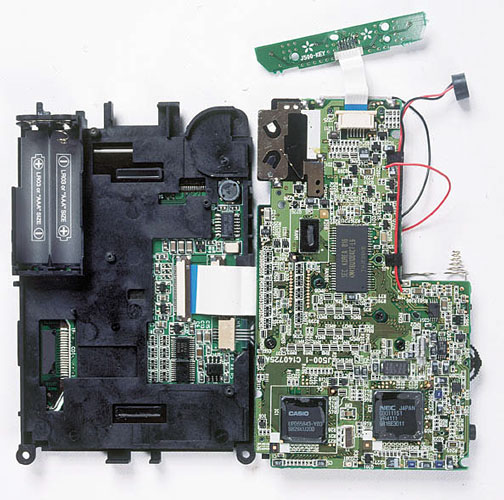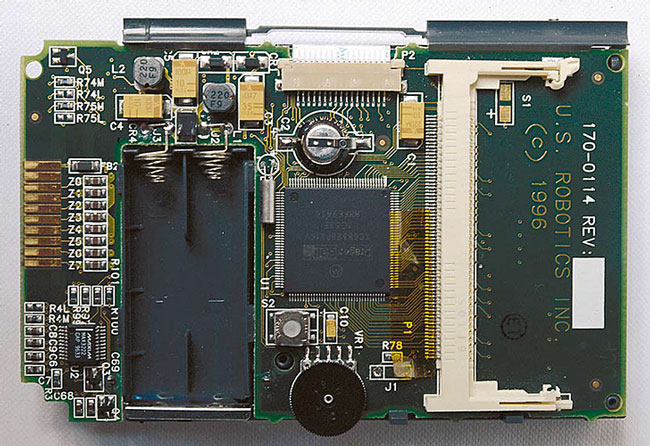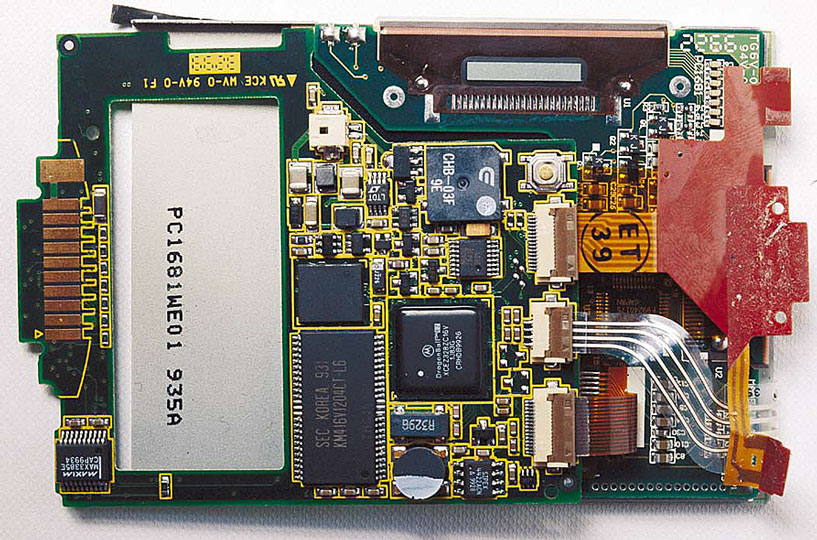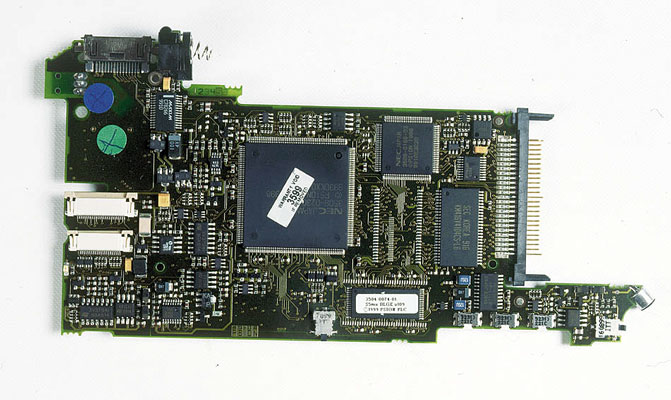I am sure most owners of PDA would be very interesting to look at the "stuffing" their pocket assistants. However, for several reasons - whether it's reluctance to break the warranty seal or just a fear of something to break - not all of this venture. Therefore, we will make this part of the work for them. At our disposal Casio E-1911 Pocket-size PC, Palm III, Palm V, and Psion Series 5mx. This is not the latest model of the CCP, but, perhaps, one of the most common. Let's start with the family of Windows CE - the very "young" from all those listed. In fact, an attempt to Microsoft "transfer" its dominant position in the market for desktop systems in the sector of the CCP. Indeed, the first time after his appearance on PDA running Windows CE in great demand - it is so tempting to have a pocket device with a familiar "desktop" interface. Alas, all the other desktop "charms" are also moved in the "pocket" operating system - and familiar to the instability of the pain (especially in the first versions of the system), and cumbersome, and inefficient use of system resources - everything was "on site". However, unlike desktop PCs with their hundreds of megabytes and megahertz, handheld devices have much more modest resources. Hence the frequent "freezes, slow performance and other shortcomings of the first versions of Windows CE. Today, the frequency processors PDA Windows CE approach to desktop PCs, the memory grows, but all this "eats" the growing needs of the new system. The situation is completely analogous to what happens in the desktop world. Yes, and application functionality and is far from the desktop. Casio E-11 - one of the first bezklaviaturnyh PDAs based on Windows CE 2.0. Line of Palm-size PC - an obvious attempt to select a niche at the Palm, however, rather unfortunate.
 |
By today's standards, machine more than the weak: frankly slow 49MGts RISC processor NEC VR4111 obviously "not pulling" when working with and so very leisurely Windows CE, monochrome screen is 240x320 pixels, though with a backlit, but also clearly too small for this OS, one of the Its main advantage is still considered a resemblance to the "desktop" Windows (which is not too feels at ease and at screen resolution 800x600 pixels). The device had 8MB of RAM and 8 MB of ROM, serial and infrared ports, could work with the cards Compact Flash. Also had a microphone and speaker for recording / playback of sound, which made it possible to use the device as a voice recorder (although not for long - in 8MB of memory does not sound much vpihnesh). The design of the motherboard rather unpretentious: the left is a compartment for compact flash cards from the top headphone jack, controls (including jog-switch for scrolling) and two compartments for the batteries. In the upper left corner of the infrared port (transmitter and receiver). In the center of the board - the most interesting: removable mini-board ROM. The presence of this removable board suggests that the Casio planned to release ROM with the new version of the system to upgrade the PDA, but as far as we know, this was not done. White trail connects the different parts of the board. Fee to all other bilateral, on the other side is the memory chip (center), bottom right - the processor NECVR4111. Nice family of Palm is highly conservative with respect to the hardware. Over the past few years, "stuffing" Palm'ov not undergone any significant change in how: all the same long-obsolete 16-bit processor, Motorola DragonBall, the same screen with a resolution of 160x160 pixels. Of course, image quality was better, but this change is more evolutionary in nature. Also changed very little operating system - it continues to single-tasking, it lacks built in support for external media cards such as Compact Flash, not provided by other screen resolutions other than 160x160 pixels. Nevertheless, "plug-in organizer" Palm has more than half of global PDA market.Palm devices have a standard graphical touch screen, serial port RS-232 and an infrared port, from 2 to 8 megabytes of RAM, and around 1 MB flash ROM, which stores an operating system (there is also a model with a non-modifiable ROM, for example, Palm M100 or Palm IIIe ). Flash memory allows you to easily update the operating system as new versions. Osnovnyemi trumps Palm has always been small size, fairly easy-entry system Graffiti, perfect synchronization with desktop PCs and almost complete openness of the system, which makes it extremely attractive to developers - and for the Palm has created tens of thousands of applications for all occasions. Now look inside, starting with the older model Palm III.
 |
Here everything is all up to primitive simple: in the very center of the board is a processor Motorola DragonBall - the heart of all PDA Palm. Processor, this is remarkable, and that includes everything needed to operate a device: the actual processor and LCD controller and memory. Therefore, it is virtually the only major chip on the motherboard. Everything Else - ancillary items such as coordinated resistors, capacitors and inductors. To the left of the processor is a backup battery that allows you to replace the main batteries without losing any of the figures feeding for a short time memory. Board located on the right rotary control screen brightness, below the battery compartment on the left connector for the LCD screen. At the bottom of board serial port RS-232, which is usually used to exchange with PCs (for the aid of a special docking station or cable HotSync), or an external peripheral (eg, modem, pager or other device, SlyFox, for whom "the third series of" Palm image do a great many). At the top of the board - slot for memory modules. And finally, Palm V - the most "advanced" to date technologically model of Palm Computing.
 |
The design of the motherboard is somewhat more complicated than the Palm III - to take at least the fact that the motherboard is now composed of several parts connected by a cable-trains. In the bottom center of all the same Motorola DragonBall, the truth is more "cute" (than the Palm III) performance. Again, this is almost the only large chip on the motherboard. To the left of the CPU chip RAM, above the flash ROM on the right (under the CPU) - "pill" back-up battery (by the way, the Palm V is no replacement batteries - in this model is used batteries). In the left part of the board - serial port RS-232, beneath them control chip (UART). By the way, due to non-Palm III form factor Palm V is completely incompatible with the periphery, although recently there have been special adapters that allow to solve this problem. As can be seen in the photo, the board consists of two halves, linked to each other cables. Over the connectors connecting cables are located the most important - the button Reset :-), but at the very top of the board - a connector for the screen. At the completion of the review - "The English Patient" Psion Series 5mx. British company Psion PLC - the actual founder of the "genre" PDA. That Psion released in 1982. Organizer, is the first mobile information device.
 |
Psion Series 5mx has 36MGts processor ARM710T, which allows him to fast enough to handle most tasks. Despite the ridiculous by today's figures clock, these devices have to cope with cases faster than the bulky PDA running Windows CE with its hundreds of megahertz.EPOC32 operating system company Symbian (a consortium of companies such as Psion, Nokia, Motorola, Ericsson, Matsushita) is exceptionally reliable and easy to use. A distinctive feature of the Psion devices has always been a case design - each device has some "spice" that makes it unique - whether it be slide-out keyboard or a contraption to mount the screen. Alas, these ingenious notions were not always strong. Design Boards particular complexity is no different. In the center of the board - the heart of the device - processor ARM710T. Processor, this is remarkable in that it is also integrated display controller, memory, etc. This minimizes the set required for operation of the device chips. To his right, apparently, the controller Compact-flash produced by NEC, has the right - a memory chip (RAM). The photograph shows the device Psion Series 5mxPRO with 24Mb memory - Option Series 5mx without ROM, in which the operating system is loaded into RAM from a memory card or via serial port, which, in theory, allows you to update your operating system, such as a Palm. The photograph shows the free space for one more memory chips - apparently it is used in newer devices with 32MB of memory. At the bottom board is a chip operating system loader (a small amount of ROM). Next to her switch, which is used to turn off the device when closing the lid, or vice versa, to include at opening (depending on what the user wants - it's all customizable). White connectors on the left are used to connect the keyboard and screen. In the upper left corner - the serial port RS-232 and IR, underneath chip control port (UART). A number of "needles" on the right - slot for Compact Flash, but in the right part of the board - a microphone and micro-switch that determines whether the card slot is open Compact Flash. Everything else - service circuits and components such as resistors, agreed. Sources, Materials:







